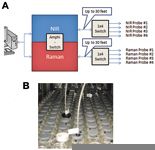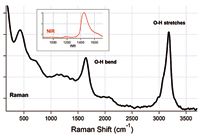Amphi-Spec: Simultaneous NIR and Raman Measurement System
A new compact instrument (Amphi-Spec) combining dispersive Raman and NIR spectroscopy has been developed at BaySpec, Inc., to deliver maximum analytical power.
A new compact instrument (Amphi-Spec) combining dispersive Raman and NIR spectroscopy has been developed at BaySpec, Inc., to deliver maximum analytical power.
Near-infrared (NIR) light sources penetrate samples deeper and greatly reduce noise from fluorescence and other background lights, as compared to visible light sources. Both Raman and NIR spectroscopy are nondestructive optical analytical techniques. NIR spectroscopy is based on absorptions or reflections in the NIR spectral region by molecular bond vibrations from the sample when illuminated by a white light source. Raman spectroscopy is also based on the molecular bond vibrations. In contrast, a Raman spectrum is dispersed stokes-shifted photons scattered from the sample when illuminated by a singlewavelength laser. Raman spectroscopy is a powerful technique for chemical identification that can be used both qualitatively and quantitatively. It has been deployed successfully in many fields, such as pharmaceuticals, medical analysis, food production, forensics, and others. Although it typically offers higher specificity and is gaining popularity, NIR spectroscopy is much faster, suitable for probing bulk material and currently used in many industries. An instrument simultaneously combining both Raman and NIR would offer maximum analytical power and flexibility.
BaySpec, Inc. recently developed an all-in-one system combining Raman (532, 785, or 1064 nm) and NIR absorption/reflection spectroscopy in a single, compact, and easy-to-use configuration (Figure 1). A simple measurement on pure water from the all-in-one system is shown in Figure 2. Two core components in the Raman/NIR all-in-one system are the SuperGamut™ spectral engine and the PeakFinder™ fiber optic probe. SuperGamut™ employs a highly efficient Volume Phase Grating (VPG®) and a deep-cooled (-60 °C) ultrasensitive CCD or InGaAs array detector, providing high-speed parallel processing and continuous spectral measurement. The PeakFinder™ fiber optic probe features optical filtering of 106 for efficient attenuation of the Rayleigh line for background-free Raman spectra.

Figure 1: (A) A design of multi-channel Amphi-Spec system. (B) Amphi-Spec in action for fast screening and characterization at molecular level.
The probe is lightweight, compact, and flexible, readily used with a sample holder for routine measurements of liquids and solids, or simply as a point-and-shoot approach. The Rayleigh filtering can be conveniently turned on and off to switch between Raman and NIR spectral measurements. All components in the all-in-one system utilize polymer-encased fiber optic cables with standard connectors for easy coupling to various light sources, lasers and spectrographs, permitting extremely flexible sample configurations.

Figure 2: Raman spectrum and NIR absorbance spectrum (insert) of pure water at room temperature measured by the all-in-one system.
Amphi-Spec systems, and SuperGamut™ Raman/NIR spectral engines and PeakFinder™ Raman/NIR probes are now available from BaySpec. Additional custom configurations are available upon request.

BaySpec, Inc.
1101 McKay Drive, San Jose, CA 95131
tel. (408) 512-5928, fax: (408) 512-5929
Website: www.bayspec.com, email: sales@bayspec.com

Thermo Fisher Scientists Highlight the Latest Advances in Process Monitoring with Raman Spectroscopy
April 1st 2025In this exclusive Spectroscopy interview, John Richmond and Tom Dearing of Thermo Fisher Scientific discuss the company’s Raman technology and the latest trends for process monitoring across various applications.
A Seamless Trace Elemental Analysis Prescription for Quality Pharmaceuticals
March 31st 2025Quality assurance and quality control (QA/QC) are essential in pharmaceutical manufacturing to ensure compliance with standards like United States Pharmacopoeia <232> and ICH Q3D, as well as FDA regulations. Reliable and user-friendly testing solutions help QA/QC labs deliver precise trace elemental analyses while meeting throughput demands and data security requirements.